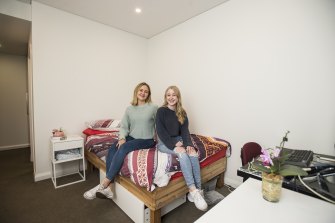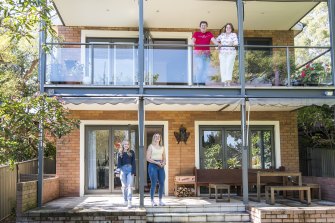Boomers deepen housing crisis by staying in empty nests
“From my point of view, we’ve got a lot more options by hanging onto the place as long as we can rather than downsizing or doing something before we retire in full.”
Her 24-year old daughter Nicole, who rents in Camperdown, said it would be difficult to buy an entry level apartment, let alone a house, which is some years away for her.
“It is harder to save for a deposit when you are paying rent. I would be more inclined to move back in with my parents when I’m serious about my property goals,” Nicole said.
Emanuel Comino of McGrath Leichhardt said Baby Boomers increasingly factored in their adult children returning home as a reason not to downsize.
“It’s certainly something they consider. I spoke to a client who is doing exactly that,” he said. “They’re looking at downsizing but won’t do so until their last of their dependents has either secured a home or has made a decision to move.”
For first-home buyer Claire Walker, returning to her family home in Strathfield allowed her to buy her own place in Dulwich Hill a lot sooner.
“A two bedroom apartment was probably not what I thought I would be purchasing as my first home two years ago. But I guess that’s the cards we’ve been dealt with,” she said.
“We couldn’t have done it without our parents. I always thought we’d have a big block of land as our first house but it looks like everyone is going to somewhere smaller.“
While Ms Walker’s parents have contemplated downsizing, they are happy where they are. It allows them to accommodate their children and grandchildren when they come back home.
Henny Stier, principal buyer’s agent at OH Property Group, says the cost of childcare is another reason many Baby Boomers hold onto the family home.

Nicole and Ashley Reed have moved into their own flat.Credit:Steven Siewert
“With childcare being so expensive, there are a lot of people who are taking care of grandchildren so the grandparents do need the backyard, the spare bedrooms,” Ms Stier said.
Rebecca Bissett owned a home in Epping until last year but still chose to move to her parents’ place in Hunters Hill with her husband and three children while they searched for an appropriate housing upgrade.
“Instead of renting, my parents have a really large home and we thought we’ll move in with them. We were wanting to upgrade in the Putney [and] Concord area,” Ms Bissett said.
Changing suburbs
The retirement of the Baby Boomer generation – born between 1946 and 1961 – is reshaping the demography of many Sydney suburbs. In the north shore and eastern suburbs – both high amenity districts well connected to the CBD – the number of workers has stagnated.
Over the two years to April 2021 total employment in the north shore’s statistical district fell by 13,000. In the eastern suburbs employment declined by 5000 over the same period.
“This suggests the fall in employment is being driven more by demographic change, such as Baby Boomers leaving the labour force, than by economic factors,” says Rawnsley.
In contrast, employment in many Sydney districts much further from the CBD, and with younger age profiles, registered solid employment gains in the two years to April 2019 despite the effects of last year’s recession. This includes Parramatta (+8000), Sutherland (+5600), the outer western suburbs (+4000) and Blacktown (+3300).
The share of over-65s living in much of Sydney’s north shore and eastern suburbs is now well above the city-wide average, according to data from the Public Health Information Development Unit at Torrens University.
A different retirement
Terry Rawnsley says the lifestyle preferences of Sydney’s retirees have shifted. “In past generations, as people hit retirement age they were thinking about moving up the coast or into a retirement village, and when that happened it opened up housing for new people to move in,” he said.

Claire Walker with partner Hugh and her parents outside their family homeCredit:Steven Saphore
“There are still some people doing for sure, but in the current Baby Boomer generation more people seem to be staying put because of the lifestyle it provides, like the cafes and other amenities … they seem to be more tied to an urban lifestyle than perhaps previous older generations were.”
Rebecca Bissett said her parents, who are retirees, have no intention of downsizing because they love their space and the neighbourhood.
“They’re in good health. They’re only young themselves, in their 60s and they’re in a good area. They don’t want to move,” she said. “I don’t envision them ever selling the home. They built that themselves. It’s their dream home.”
Catherine Murphy of The Agency North said some home owners were also fearful of change.
“When people have been in their community and their home for a very long time, there is a fear of what’s next? And is the grass any greener [when downsizing]?
“When I’m talking about selling, they ask: ‘But where will I go? I don’t want to share a wall with someone else. I don’t want to pay strata’, ” Ms Murphy said, adding that strata fees were a big bone of contention for would-be downsizers.
Older Australians are also staying attached to the jobs market for longer.
“For many, retirement is the trigger to shift from the empty nest family home but that is being delayed because in a knowledge economy older people can keep working a lot later in life,” said social researcher, Mark McCrindle.
The high quality health services in inner Sydney are attractive, and there are also many barriers to downsizing.
A recent Grattan Institute report on housing affordability concluded the failure to build more medium-density housing in established suburbs means older people lack downsizing options in their local area.
Kathleen Synnott of Atlas Northern Districts says a lack of local smaller alternatives forces Baby Boomers in many suburbs to stay put for longer. She says downsizers face stiff competition for townhouses and villas from younger buyers including first-timers.
“The reason why I see people holding on [to the family home] is that they haven’t got, in their minds, a wonderful choice out there … it is not a good enough driver [to move],” Ms Synnott said. “Changing an area and a home for them is bigger than Ben Hur for them.”

Dana Reed and her husband Rodney at their inner west house with their daughters Nicole and Ashley, who have moved out.Credit:Steven Siewert
Tax and welfare settings also discouraging empty-nesters from moving.
Because primary residences are not included in the age pension means test, pensioners may lose some or all of their pension if they downsize. Another disincentive is stamp duty on the purchase of a smaller home. A NSW government proposal to replace stamp duty with an annual land tax aims to reduce disincentives for moving, although this change has not yet been implemented.
A city-wide challenge
Sydney’s housing mismatch is already having far-reaching consequences. “It’s a real challenge from an urban planning perspective,” says Rawnsley.
The trend for empty-nesters to stay put limits the supply of well-located family homes which, in turn, puts upward pressure on the price of properties that do become available.
It is one of many factors contributing to the high cost of housing in Sydney. Figures released by CoreLogic last week showed the city’s median house price rose by 3.5 per cent last month, one of the biggest monthly gains since the late 1980s, to a record $1.186 million.
When prime-age workers are forced to locate a long way from work hubs it puts added pressure on overstretched transport networks as well as other basic services including schools and hospitals. If more workers are locked into long commutes it will increase the economic and personal costs of congestion.
Rawnsley warns that excluding young workers from suitable, well-located housing will drag on the economy by discouraging workforce participation. It may even reduce the fertility rate.
“When people are pushed to houses on the urban fringes they might say ‘actually I’m so far away from job options I won’t work as much’- this is particularly the case for women of child rearing age,” said Rawnsley. “So you get people dropping out of the labour force.”
Alternatively, if working couples choose to settle in a small cheaper dwelling close to their employment it may mean they have fewer children.
As the population ages, Sydney will need to find ways to better meet the housing needs of young families.
The Morning Edition newsletter is our guide to the day’s most important and interesting stories, analysis and insights. Sign up here.
For all the latest Business News Click Here
For the latest news and updates, follow us on Google News.
